The difference between Magnolia and Yucca
Phoenix tail orchid is a kind of plant that we often see in our life, and it is often planted as a green plant in roadside gardens. The flowering of Phoenix tail orchid is very much liked by many people, and the white florets are like small cups one by one. Today, the editor will introduce to you the difference between Magnolia and Yucca, the culture method of Phoenix-tailed orchid.
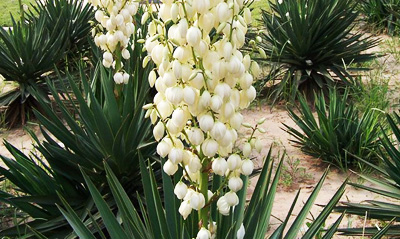
A brief introduction to Phoenix tail Orchid
Cymbidium is a perennial evergreen shrub. Stems unbranched or rarely branched. The leaf is sword-shaped, the tip is hard, spirally densely growing on the stem, the leaf is hard, the edge is smooth or there are a few white filaments when old, with white powder. Panicle 80-120 cm high. Flowers cup-shaped, drooping, petals 6, milky white. The florescence lasts more than 20 days from mid-May to mid-June, or from early August to early November. Flowers bloom one after another from the bottom up, reaching 300 to 400 flowers. Cucurbit oval-shaped. The fleshy root is stout and easy to sprout.
The Culture method of Cymbidium
Phoenix tail orchid is native to eastern and southeastern Africa. Strong adaptability, cold and drought tolerance, Xi Yang is also resistant to semi-overcast, soil requirements are not strict.
Cultivation and management methods: Cymbidium is easy to manage after planting, only need to trim the withered branches and leaves at any time and cut off the pedicels in time after flowering. The stem of Cymbidium which has been growing for many years is too high or inclined to reduce the ornamental value, so it should be cut off and renewed. During the growing period, according to the condition of the plant, topdressing was applied irregularly and watered according to the soil condition.
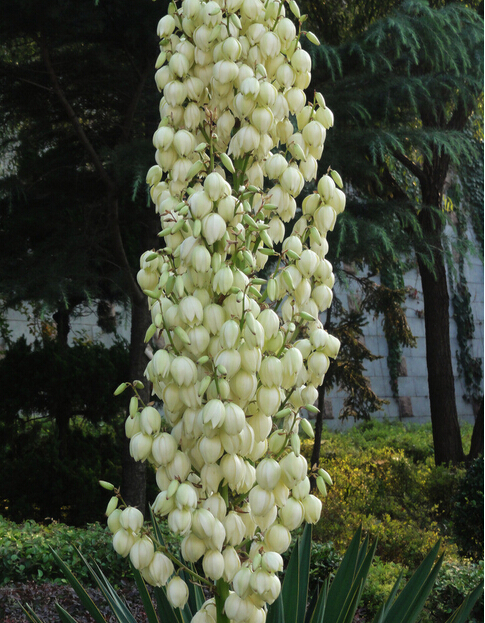
The difference between Magnolia and Yucca
Silk orchid, fleshy whisker root system. When young, the stem is very short, and the leaves often rub the ground in clusters. Stem boss extends into a small treelike, about 2 meters high, stem bark dark brown, fibrous, rarely branched. Leaf sword-shaped, 30 to 60 meters long, about 3 meters wide, thick leathery, straight and hard, apex acuminate into a needle, leaf surface gray-green, both sides are slightly powdered, the edge is separated with white fibrous filaments, so it is also known as rough edge Yucca. Large panicles drawn from leaves, with stout peduncles, about 3 to 5 meters in diameter, yellowish green, soft texture, each plant can produce 1 to 2 branches, often more than half of the leaves. Flowers on the side around the pedicel, with short pedicels, Corolla cup-shaped, milky yellow, drooping growth, petals 6, opening one by one from bottom to top. The capsule is elliptic-ovate and is sterile in the north due to the decrease in temperature after anthesis, and the peduncle dries up. The flowering period is from September to October, which can bloom for about a month. Var. variabilis, leaves with yellow or white stripes. Yellow-edged Yucca, leaf margin yellow, apex slightly round, and apiculate, slightly reddish at base.
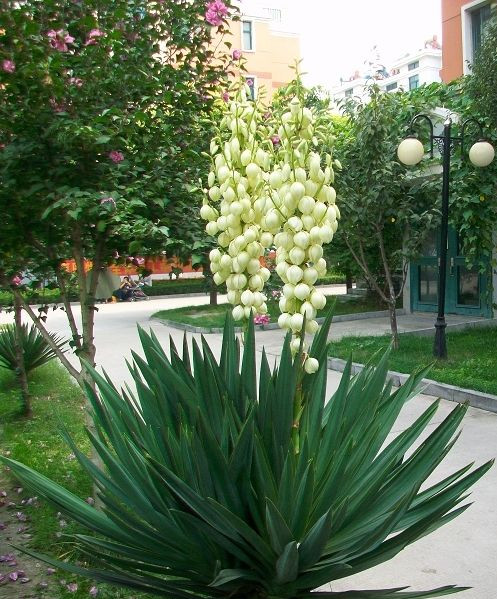
Phoenix tail orchid, also known as thick-leaf magnolia. Stem less than 3 m tall, solitary, unbranched. The leaves are thick and leathery, 50 to 80 feet long and 5 to 7 meters wide. The leaf surface is wrinkled, dark green, covered with a small amount of white powder, firm and oblique extension, the leaf margin is smooth and without white silk, usually sparsely toothed, with a small amount of silk thread when old. Flowering between summer and autumn, flowering stems from the leaves, upright height of 1 m to 1.5 m, flowers drooping, inner edge of pure white, outer edge of green and white, slightly reddish, flower diameter of 8 to 10 meters. Capsule dry, oblong-ovate, with 6 grooves, 5 cm to 6 cm long, not dehiscent. Varieties are small Phoenix tail orchid, variegated leaf Phoenix tail orchid and so on.
Growth habits of Cymbidium
Phoenix tail orchid perennial dark green, flowers, leaves are beautiful, strange tree shape, several clumps, different height, leaf shape, flowering stem towering, white, numerous white flowers drooping such as bell, graceful, long-lasting florescence, pleasant fragrance, is a good garden ornamental trees, but also a good material for fresh cut flowers. It is often planted in the center of flower beds, in front of buildings, in lawns, poolsides, terraces, buildings, roadsides and hedges.
The leaf fiber is white, tough and water-resistant, which is called "white hemp brown" and can be used as a cable. Somatic hormones can also be extracted from leaves.
The method of dividing plants can be used to propagate Cymbidium. Cymbidium plants cultivated for many years will sprout small plants from the roots. When the small plant grows up slightly, cut it away from the mother plant. Those with roots can be planted directly, and those without roots can be used as cuttings; smear sulfur powder on the incision, then plant it in sterilized plain sand and place it in the shade. Take root after about 50 days and move to a sunny place for cultivation.
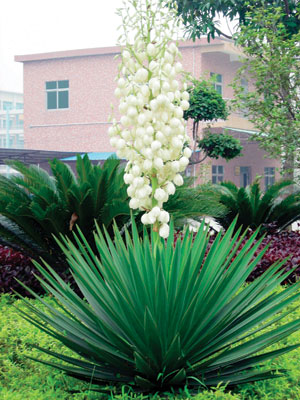
Phoenix tail orchid is strong in nature, rarely occurs diseases and insect pests and has strong resistance to sulfur dioxide, hydrogen fluoride, chlorine and ammonia. At the same time, it can also absorb harmful gases. Cymbidium is suitable for planting in flower beds, lawns or rockery; family cultivation can be grown in larger pots; small plants with sprouting tillers can also be cut from the roots, planted in small flower bowls and placed on several tables.
The characters of Cymbidium
Like warm, humid and sunny environment, cold tolerance, shade tolerance, drought tolerance and moisture tolerance, lax soil requirements. It has strong resistance and absorption ability to harmful gases such as SO2, HCl, HF and so on. The experiment shows that when the average daily concentration of sulfur dioxide is 0.15ml ∕ cubic meter, many trees such as pine and cypress, heather, Yingchun, paulownia and so on have serious damage symptoms, while Yucca is still tall and strong. Silk orchid also has a strong ability to absorb hydrogen fluoride, according to the determination, 1 kg of dried leaves can absorb 266 mg of fluorine.
Like warm, humid and sunny environment, but also resistant to shade, anti-pollution, strong sprouting, strong adaptability, stop growing at the top after flowering, and lateral buds occur on the side of leaf scars. Strong, cold-resistant, drought-resistant, moisture-resistant, barren-resistant, lax in soil and fertilizer requirements. Strong growth, low requirements for soil fertilizer, but like sandy soil with good drainage. It can resist pollution. It has strong resistance to harmful gases such as SO2, HCl and HF, and can grow except saline-alkali soil. There are strong fleshy roots, the stem is easy to produce adventitious buds, it is easy to grow and sprout, expand the plant, and has a strong ability to renew.
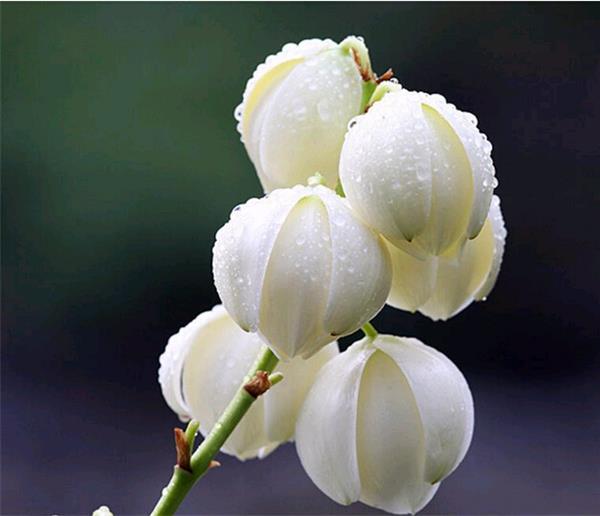
After reading the above content, I believe you have a certain understanding of the difference between Phoenix-tailed orchid and yucca in the breeding method of Phoenix-tailed orchid. For the cultivation of Phoenix tail orchid, it is very easy.
Planted in a small flower bowl and placed on several tables.
The characters of Cymbidium
Like warm, humid and sunny environment, cold tolerance, shade tolerance, drought tolerance and moisture tolerance, lax soil requirements. It has strong resistance and absorption ability to harmful gases such as SO2, HCl, HF and so on. The experiment shows that when the average daily concentration of sulfur dioxide is 0.15ml ∕ cubic meter, many trees such as pine and cypress, heather, Yingchun, paulownia and so on have serious damage symptoms, while Yucca is still tall and strong. Silk orchid also has a strong ability to absorb hydrogen fluoride, according to the determination, 1 kg of dried leaves can absorb 266 mg of fluorine.
Like warm, humid and sunny environment, but also resistant to shade, anti-pollution, strong sprouting, strong adaptability, stop growing at the top after flowering, and lateral buds occur on the side of leaf scars. Strong, cold-resistant, drought-resistant, moisture-resistant, barren-resistant, lax in soil and fertilizer requirements. Strong growth, low requirements for soil fertilizer, but like sandy soil with good drainage. It can resist pollution. It has strong resistance to harmful gases such as SO2, HCl and HF, and can grow except saline-alkali soil. There are strong fleshy roots, the stem is easy to produce adventitious buds, it is easy to grow and sprout, expand the plant, and has a strong ability to renew.

After reading the above content, I believe you have a certain understanding of the difference between Phoenix-tailed orchid and yucca in the breeding method of Phoenix-tailed orchid. For the cultivation of Phoenix tail orchid, it is very easy.
Related
- Wuhan Hospital Iron Tree Blooming Result Was Instantly Frightened by the Gardener Master
- Which variety of camellia is the most fragrant and best? Which one do you like best?
- What is the small blue coat, the breeding methods and matters needing attention of the succulent plant
- Dormancy time and maintenance management of succulent plants during dormancy
- Minas succulent how to raise, Minas succulent plant pictures
- What are the varieties of winter succulent plants
- How to raise succulent plants in twelve rolls? let's take a look at some experience of breeding twelve rolls.
- Attention should be paid to water control for succulent plants during dormant period (winter and summer)
- Watering experience of twelve rolls of succulent plants
- Techniques for fertilizing succulent plants. An article will let you know how to fertilize succulent plants.



